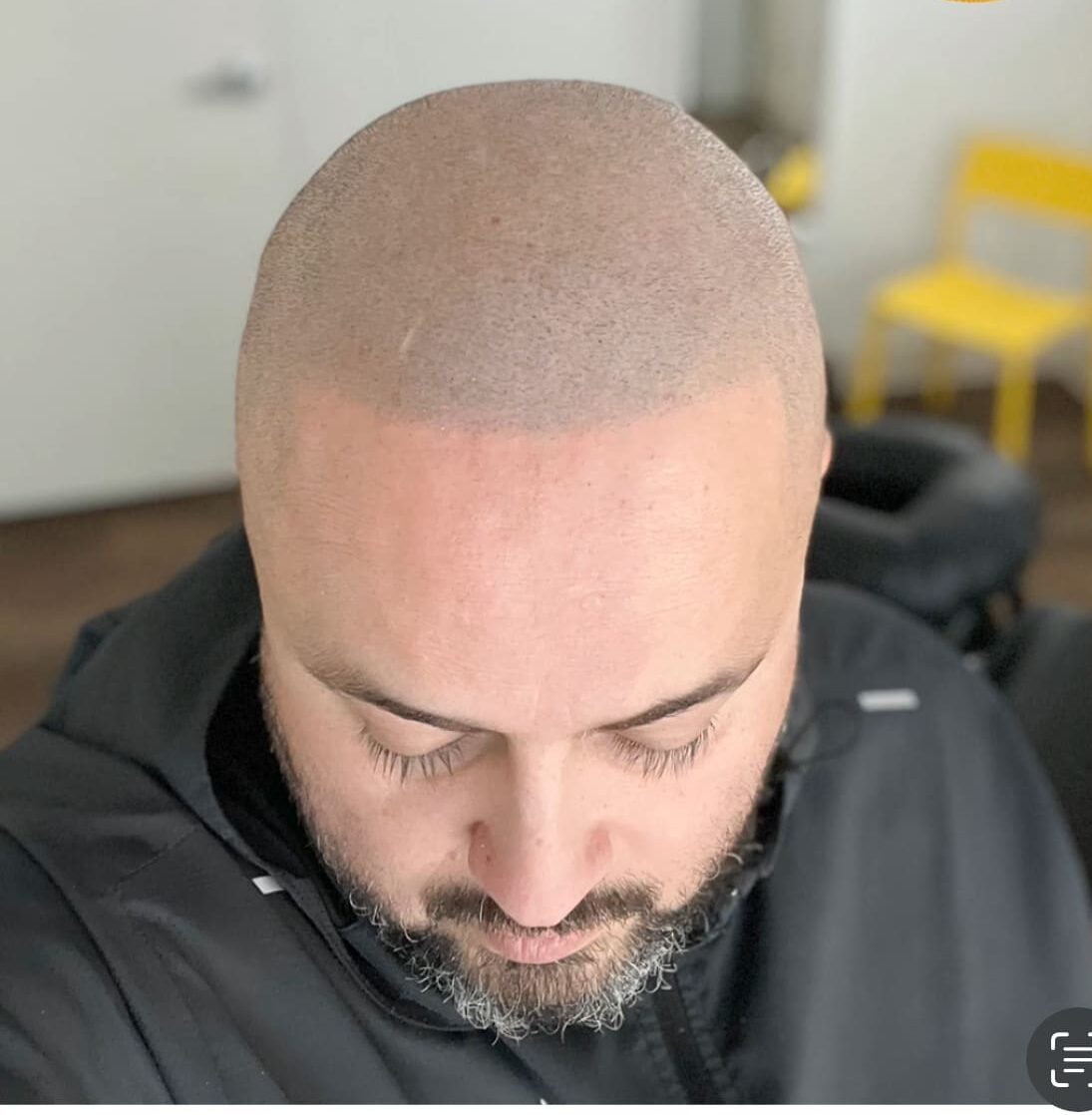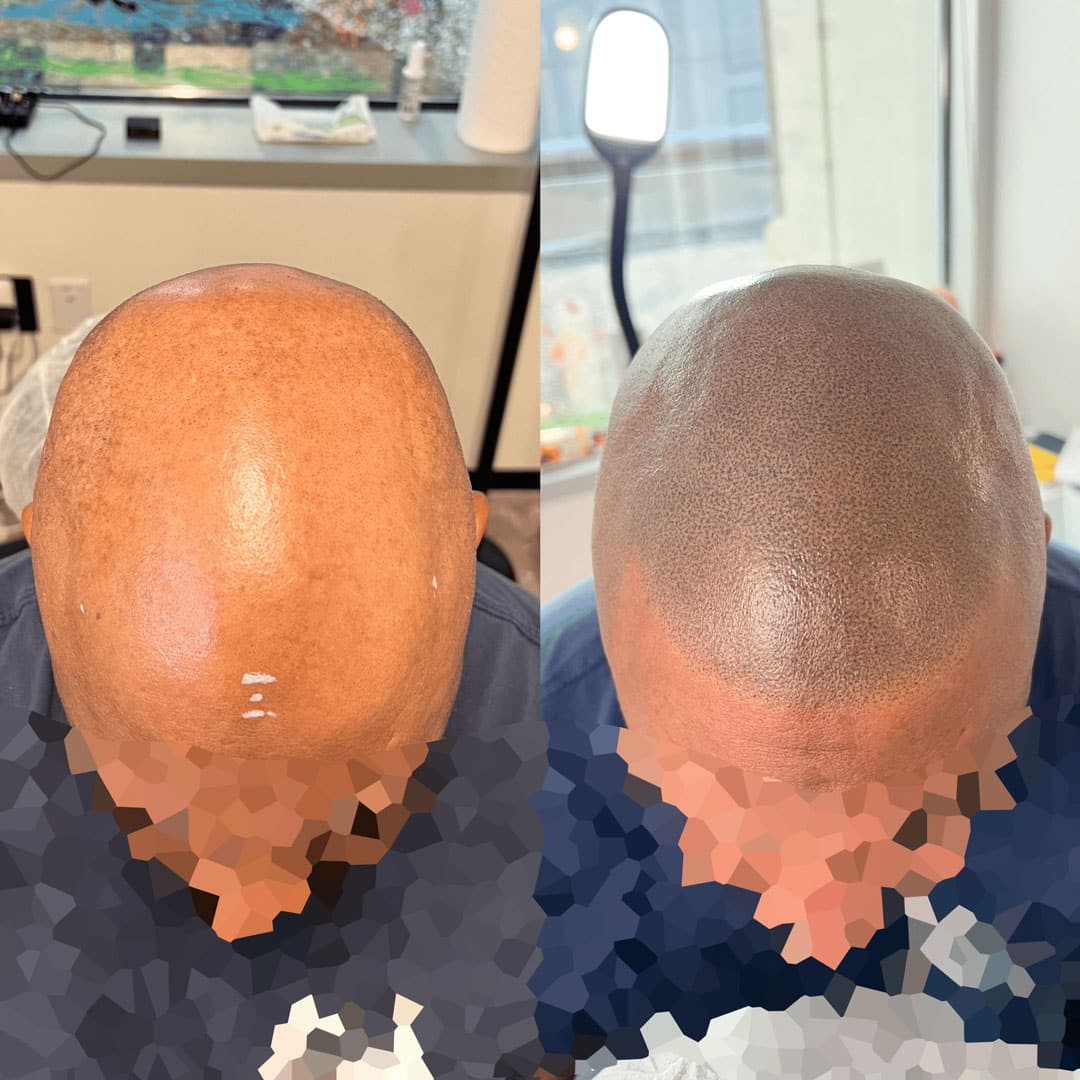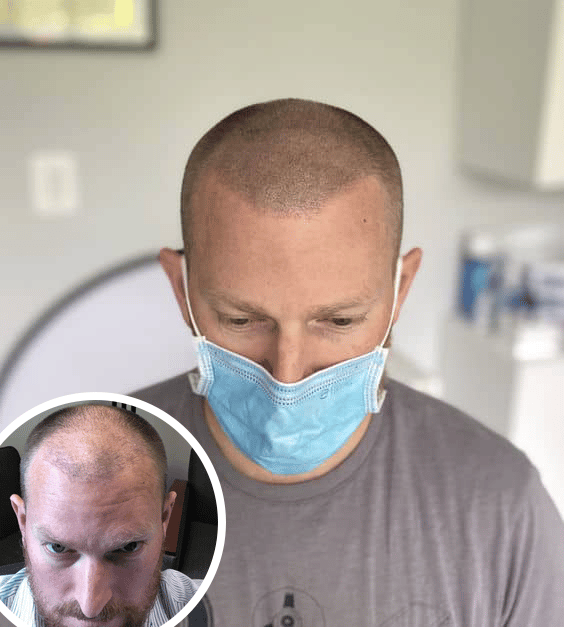Struggling with hair loss can be a deeply personal and often distressing experience. Whether you’re dealing with a receding hairline, thinning crown, or visible scalp areas, the impact on your self-confidence can be significant. In your search for solutions, you’ve likely come across a number of options, but two stand out in the realm of effectiveness and popularity: scalp micropigmentation (SMP) and hair transplant surgery.
In this article, we’ll discuss scalp micropigmentation vs. hair transplant —the nuances, benefits, and considerations of each option so you can make an informed decision that aligns with your needs and lifestyle. For those interested in SMP, Edge Scalp Ink in Maryland specializes in providing SMP services to correct any issues you have with a prior hair transplant or even complement your recent transplant before it kicks in.
Contact Edge Scalp Ink today for a free scalp micropigmentation consultation, and let us help you achieve the appearance of a full head of hair.

Understanding Scalp Micropigmentation
Scalp micropigmentation (SMP) is an innovative and non-invasive cosmetic technique that has gained significant traction in the field of hair restoration. At its core, SMP is a specialized process that replicates the appearance of natural hair follicles by applying natural pigments onto the scalp. This method effectively creates the illusion of a fuller head of hair or conceals areas affected by hair thinning and baldness. Think of SMP like a hair tattoo.
Unlike surgical hair restoration methods, SMP involves minimal discomfort and virtually no downtime. Clients can usually resume their normal activities soon after each session. The pigments used are also specifically designed for SMP, ensuring safety and compatibility with the scalp.
How is SMP Performed?
At Edge Scalp Ink, the SMP process is a blend of art and science, requiring a high level of skill and precision. It is performed using specialized micro-needles that gently deposit pigment into the scalp.
Each session of SMP can last between two to four hours, depending on the area’s size and the complexity of the work required. The process is typically spread out over two to three sessions, with a few weeks in between each session. This phased approach allows for gradual enhancement of the scalp’s appearance, ensuring a natural-looking density and shade. The practitioner carefully layers the pigment, adjusting the depth, angle, and distribution to mimic natural hair growth patterns. This assures that the scalp micropigmentation treatment looks natural and only as light or dark as the client wants it.
The Pros of SMP
Scalp Micropigmentation (SMP) has emerged as a leading solution in the world of hair restoration, offering numerous benefits to individuals grappling with hair loss, including:
- Non-Invasive with Minimal Recovery Time: One of the most significant advantages of SMP is its non-invasive nature. Unlike surgical hair restoration methods, SMP does not involve incisions or stitches. This means there is minimal discomfort during the cosmetic procedure and virtually no downtime. Most of our clients return to work right after the treatment.
- Long-Lasting Results: Scalp micropigmentation provides results that last for years. While the pigment may gradually fade over time, touch-up sessions every few years can easily refresh the look. This durability makes SMP a cost-effective long-term solution compared to other hair loss treatments that require ongoing maintenance or repeat procedures.
- Effective in Hiding Scars, Thinning, and Bald Spots: SMP excels in camouflaging various forms of hair loss. It effectively hides scars from a previous hair transplant surgery, injury, or burn. For those with thinning hair, SMP adds density, creating the illusion of a fuller head of hair. It also seamlessly covers bald spots, blending them with existing hair for a natural and cohesive appearance.
- Enhances the Look of a Fuller Head of Hair: Scalp micropigmentation provides a realistic and natural-looking solution to hair loss. By replicating the appearance of hair follicles, it gives the illusion of a full head of closely-shaved hair or, for clients with longer hair, it dramatically increases hair density. This can significantly enhance an individual’s appearance, contributing to a more youthful look.
Cons of SMP
While scalp micropigmentation is a popular choice for hair restoration due to its numerous benefits, there are a few considerations to keep in mind.
- Semi-Permanent Nature: SMP is not a permanent solution and may require touch-ups every few years to maintain its appearance.
- Limited to a Shaved Look: For a full head application of SMP, it works best for those who prefer the appearance of a shaved head, which may not suit everyone.
- Potential Color Fading: Over time, the pigments used in SMP may fade, particularly if exposed to the sun frequently. This necessitates periodic maintenance.
Who is an Ideal Candidate for SMP?
Individuals with hair thinning, pattern baldness, or alopecia are prime candidates for scalp micropigmentation. The cosmetic procedure effectively masks areas where hair density has decreased, restoring the appearance of a fuller head of hair. Those with scars on the scalp, whether from injuries, surgeries, or hair transplant procedures, can also greatly benefit from SMP. The technique effectively blends the scar tissue with the surrounding area, making the scars less noticeable.
A significant advantage of SMP is its versatility. The procedure is suitable for all skin types and colors, ensuring that anyone, regardless of their skin tone, can achieve natural-looking results regardless of skin tone.

Hair Transplants: An Overview
Hair transplants have offered hope for many grappling with hair loss as a permanent solution to restore not just their hair but also confidence and self-esteem. This surgical procedure has evolved significantly over the years, now providing more natural-looking and effective results than ever before.
A hair transplant surgery is precise and requires a skilled medical team. It begins with carefully selecting healthy hair follicles from a different part of the body (donor site) that are most likely to thrive in the new area. These follicles are then transplanted to the thinning or balding regions. The goal is to achieve a natural and seamless result, blending with the existing hair pattern and growth direction.
Whether you’re just beginning to explore hair restoration options or are considering a hair transplant as your chosen path, this guide will provide valuable insights into this transformative procedure.
Scalp micropigmentation is an amazing complement to hair transplants. The SMP gives the client’s scalp the extra density it needs to make the transplant fully worthwhile.
Different Types of Hair Transplant Procedures
Follicular Unit Transplantation
Follicular Unit Transplantation, or FUT, is one of the traditional methods of hair transplantation. In this procedure, a strip of skin containing numerous hair follicles is removed from the donor area, usually the back of the scalp, where hair is more resistant to balding. This strip is then carefully dissected under a microscope into individual follicular units containing one to four hairs each. These units are then transplanted into the recipient area.
The primary advantage of FUT is the ability to transplant many grafts in a single session, making it ideal for covering larger bald areas. However, it leaves a linear scar at the donor site, which can be a consideration for those who prefer shorter hairstyles. Sometimes, the linear scar is very wide, making it very prominent if the client needs to shave their head.
Follicular Unit Extraction
Follicular Unit Extraction, or FUE, is a more modern approach and has gained popularity due to its less invasive nature. In FUE, individual hair follicles are extracted directly from the scalp rather than removing a strip of skin. This technique requires great precision and is typically more time-consuming than FUT.
However, it has the advantage of leaving no linear scars, as each follicle is removed individually. This results in a more natural-looking outcome and a shorter recovery time. FUE particularly appeals to those who wear their hair short, as the tiny scars left by the extraction are virtually unnoticeable.
The Pros and Cons of Hair Transplants
Hair transplant surgery has become a popular and effective solution for hair loss, offering transformative results for many. However, as with any medical procedure, weighing the pros and cons before deciding is essential.
Pros of Hair Transplants
Permanent and Natural-Looking Results: One of the most significant advantages of hair transplants is that they are permanent. The transplanted hair follicles are genetically resistant to balding, meaning they will continue to grow for a lifetime. This aspect provides a long-term solution to hair loss. Additionally, hair transplants yield natural-looking results. The hair grows, feels, and behaves like the original hair in the area, providing a seamless and authentic appearance.
Eliminates Balding Areas: Hair transplants are particularly effective in addressing bald patches and receding hairlines. They offer a way to fill in these areas with real hair that grows naturally. This can significantly improve the appearance of the scalp.
Cons of Hair Transplants
Invasive with a Longer Recovery Time: Unlike non-surgical hair restoration methods, a hair transplant is a surgical procedure. This means it is more invasive, requiring local anesthesia and potentially sedation. Post-surgery, patients may experience discomfort, swelling, and a recovery period during which they may need to limit certain activities. The recovery time can vary but is generally longer than that of non-surgical alternatives.
Optimal Results are Not Guaranteed: After the hair transplant surgery, clients are told they need to wait between six months to a year to see the full results. These companies will reimburse you for groups of hair follicles that did not grow as expected.
Risk of Scarring and Infection: As with any surgical procedure, there is a risk of scarring and infection. In the case of FUT (Follicular Unit Transplantation), there is a linear scar where the strip of the scalp is removed, and then the remaining edges are stapled together. While typically hidden by hair, this scar might be a concern for those who prefer short hairstyles. FUE (Follicular Unit Extraction) minimizes visible scarring but still involves small incisions with a risk of infection.
Costly Compared to Non-Surgical Alternatives: Hair transplants can be more expensive than other hair restoration methods. The cost reflects the surgical nature of the procedure, the expertise required, and the permanence of the results. For many, this is a significant investment, and it’s important to consider the financial implications.
Suitable Candidates for Hair Transplants
Ideal candidates for hair transplant procedures are those with sufficient donor hair on the back and sides of their scalp, as the quality and quantity of this hair determine the transplant’s success in terms of density and coverage. Good overall health is crucial since it supports recovery and enhances the success rate of this surgical procedure.
Candidates should also have realistic expectations; while a hair transplant can improve hair appearance, it might not completely restore the original fullness. Understanding what the procedure can achieve and the importance of sufficient donor hair and general health is vital for anyone considering this option.
Comparing SMP vs. Hair Transplant
Which is More Affordable?
Scalp micropigmentation is generally a more affordable option compared to hair transplants. This difference in cost is largely due to the nature of the procedures. SMP is a non-surgical treatment that doesn’t require the same level of medical care or specialized surgical skill as a hair transplant. Additionally, SMP typically requires fewer sessions and less follow-up care, contributing to its overall lower cost.
Which Provides Quicker Results?
When it comes to seeing immediate results, SMP has a clear advantage. SMP sessions can create the appearance of a fuller head of hair right after the first treatment, offering instant cosmetic improvement. In contrast, hair transplants involve a surgical process where the transplanted hair follicles need time to heal and grow. It can take several months, sometimes up to a year, to see the full results of a hair transplant.
Which Procedure is Less Invasive?
Scalp micropigmentation is less invasive than hair transplants. A non-surgical technique, SMP involves applying pigment to the scalp’s dermis layer of skin, resulting in minimal discomfort and recovery time. On the other hand, hair transplants are surgical procedures that involve transplanting hair follicles from one part of the body to another, requiring more extensive care and a longer healing period.
Which Has Better Long-Term Results?
Regarding long-term outcomes, hair transplants generally offer permanent results. Once the transplanted hair takes root, it continues to grow naturally over the years. However, while durable, SMP is semi-permanent and may require touch-ups over time to maintain its appearance, as the pigment can fade.
Which Provides a Natural Appearance?
Both SMP and hair transplants are designed to offer a natural appearance, but the choice between them may depend on personal preference and the specific hair loss situation. SMP is adept at creating the look of density and fullness in thinning areas and can effectively simulate short hair or a closely shaved scalp. Hair transplants, conversely, involve moving actual hair and are capable of restoring longer hair and redefining hairlines in a very natural way.
How Do Treatment Durations Compare?
Due to the nature of the procedures, treatment durations for scalp micropigmentation and hair transplants differ. SMP typically requires two to three sessions, each lasting two to four hours. Follow-up sessions are usually scheduled a few weeks apart.
Hair transplants, on the other hand, require one to two sessions, each lasting four to eight hours. These sessions are usually spaced a few months apart.
Which One is More Painful?
Both SMP and hair transplants are minimally painful. Local anesthesia is used in both procedures to ensure comfort. SMP involves the use of micro-needles to apply pigment, but it’s not as intense as a typical tattoo.
Although more invasive, hair transplants also utilize local anesthesia to mitigate pain during the procedure. Any discomfort experienced post-procedure is usually mild and can be managed with prescribed pain relievers.
Which One Has More Potential Side Effects?
Both SMP and hair transplants carry potential side effects, but the nature and severity can differ. SMP’s side effects are generally minor, including redness, itching, and slight swelling, which subside shortly after treatment.
Conversely, hair transplants may involve more side effects, such as bleeding, infection, or scarring, especially with the FUT technique. While rare, these side effects are associated with the surgical nature of the procedure and require careful post-operative care to manage.
Which One is Cheaper?
Generally, scalp micropigmentation is more affordable than hair transplants. The cost-effectiveness of SMP comes from its non-surgical technique, requiring fewer resources and less specialized medical oversight compared to the surgical and labor-intensive nature of hair transplants.
Which One Has a Longer Recovery Time?
SMP boasts a minimal recovery time, with most patients able to resume their daily activities immediately after the procedure. In contrast, hair transplants, being a surgical procedure, typically require a longer recovery period. Patients may need several days to a week to recover from the initial surgical effects.
It may take several months before the full results of the hair transplant are visible. This extended recovery period reflects the invasive nature of the procedure and the body’s need to heal from the surgical transplantation of hair follicles.
Getting SMP After a Hair Transplant
Opting for scalp micropigmentation (SMP) after undergoing a hair transplant is a decision many individuals consider to further enhance the overall appearance and density of their hair. This combination can be particularly beneficial in certain situations:
- Enhancing Density: While hair transplants effectively redistribute hair to thinning or balding areas, some individuals may still desire greater density. SMP can add the appearance of thickness and fullness to these areas, complementing the transplanted hair.
- Camouflaging Scars: Hair transplant surgeries, especially Follicular Unit Transplantation (FUT), can leave scars. SMP can be skillfully used to camouflage these scars, making them less noticeable by replicating the appearance of hair follicles in the scarred area.
- Addressing Uneven Growth: In some cases, hair growth after a transplant might be uneven. SMP can help create a more uniform look, masking areas where growth is less dense or patchy.

How to Choose Between SMP and Hair Transplant
When deciding between SMP and a hair transplant, several factors should be taken into consideration:
- Degree of Hair Loss: The extent of hair loss is a significant factor. For those with extensive hair loss or very little donor hair, SMP might be the more feasible option. It can create the look of a full head of shaven hair without the need for actual hair follicles. Conversely, hair transplants are ideal for those with sufficient donor hair looking to restore growth in balding areas.
- Desire for Surgical vs. Non-Surgical Procedures: Personal preference regarding surgical intervention plays a crucial role. If you prefer a non-invasive method with minimal downtime, SMP is a suitable choice. On the other hand, if you are open to a surgical solution for more permanent and extensive coverage, a hair transplant would be the appropriate option.
- Budget and Maintenance Preferences: Budget constraints are also a critical aspect. Generally, SMP is more cost-effective than a hair transplant. Additionally, consider maintenance preferences. SMP requires touch-ups every few years, whereas hair transplants, after the initial growth period, require minimal additional care.
Regardless of which procedure you choose first, a scalp micropigmentation treatment can be done before or after a hair transplant procedure. Many of our clients choose SMP first since it is non-invasive, relatively inexpensive, and provides immediate results.
Consult With SMP Professionals at Edge Scalp Ink
Whether you’re exploring scalp micropigmentation as a standalone solution or considering it in conjunction with other hair restoration methods, the professionals at Edge Scalp Ink can help you make a decision. We’ll discuss the benefits and limitations of SMP, ensuring you have a clear and realistic understanding of what the procedure can achieve. Our goal is to empower you with information and confidence, enabling you to make a decision that best aligns with your expectations and desired look.
Let us be your trusted partner in achieving the appearance and confidence you deserve. Contact Edge Scalp Ink today to book your appointment and start your journey toward a fuller head of hair.

